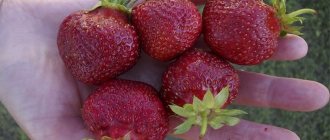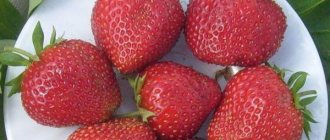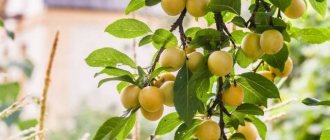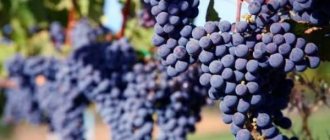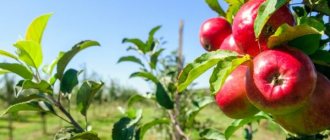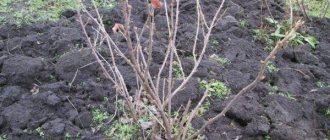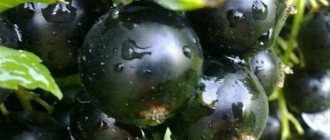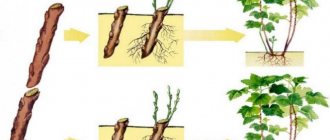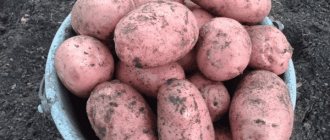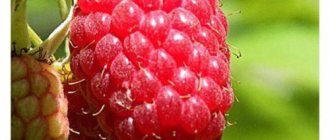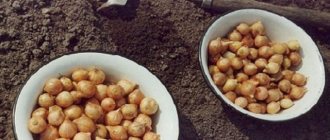History of variety selection
Black currant variety Green Haze is a hybrid plant created by breeders T.S. Zvyagin. and Sergeev K.D. at VNIIS named after. Michurina. To create the variety, the institute's staff crossed two well-known varieties of currants - Minai Shmyrev and Karelskaya.
After the hybrid was entered into the State Register in 2004, the variety began to actively spread throughout Russia. Experts note high currant yields even in regions such as Eastern and Western Siberia, the Black Earth Region, the Urals, and the Central and Western districts of the country.
Black currant 'Green haze'
Latin name: ribes nigrum 'zelenaya dimka'
Main genus: Currant
| Fruit size |
|
| Fruit shape |
|
| Fruit color | |
| Winter hardiness |
|
| Decoration of plants and fruits |
|
| Flower size |
|
| Brush characteristics |
|
| Berry/truss separation |
|
| Nut kernel size |
|
| Blush (cover color) |
|
| Fruit pulp color | |
| Density and character of the pulp (fruit/bush/yag) |
|
| Fruit aroma |
|
| Frost resistance (fruit/bush/yag) |
|
| Drought resistance (fruit/bush/yag) |
|
| Beginning of fruiting after planting |
|
| Ripening period (fruit/bush/yar) |
|
| Consumer maturity |
|
| Productivity (fruit/bush/yag) |
|
| Fruit shedding |
|
| Remontant |
|
| Self-pollinating/self-fertile |
|
| Purpose of fruits (fruit/bush/yag) |
|
| Taste of fruits (fruit/bush/yag) |
|
| Soil pH requirements (fruit/bush/yag) |
|
| Shelter for the winter (fruit/bush/yag) |
|
| Soil type (fruit/bush/yar) |
|
| Disease resistance (fruit/bush/yag) |
|
| Resistance to pests (fruit/bush/yag) |
|
| Habitus (fruit/bush/yag) |
|
| Growth form |
|
| Crown density |
|
| Thorns, thorns |
|
| Vitamin content (fruit/bush/yag) |
|
| Keeping quality of fruits (fruit/bush/yag) |
|
| Cultivation region by origin (fruit/bush/yar) |
|
Expand all properties
Description of the plant:
Black currant 'Green Haze' is a variety obtained at the All-Russian Research Institute of Horticulture named after. I.V. Michurina by crossing the varieties 'Minai Shmyrev' and 'Bredthorp'. At state variety testing since 1986.
Included in the state register in 1994 for the Central, Central Black Earth, North Caucasus, West Siberian and East Siberian regions.
Dimensions and growth form:
The bush is medium-sized, semi-spreading. The shoots are straight, pubescent.
Leaves:
The leaves are large, light green, matte, slightly wrinkled. The middle blade of the leaf blade is elongated. The teeth are sharp, short, and curved.
Flowers and fruits:
The cluster of black currant 'Green Haze' is medium in size (5–7 berries in a cluster), with a sparse arrangement of berries.
The berries are large, weighing 1.2–2.5 g, round-oval, smooth, black, shiny. They ripen at the same time, but when overripe they crack. The skin is of medium density, the peel is dry. The pulp is tasty, with a nutmeg flavor and aroma. Tasting score for fresh fruits is 4.7–5.0 points, processed products – 4.5–4.7 points. The vitamin C content is 170–190 mg%. The purpose is universal.
Precocity, ripening time, yield:
The variety is very fast-growing. Medium ripening period. It is characterized by high self-fertility and productivity (3.1–3.6 kg per bush; 1.0 kg/m²).
Winter hardiness:
Winter-hardy and drought-resistant variety.
Disease resistance:
The 'Green Haze' variety is resistant to powdery mildew and anthracnose. Not resistant enough to kidney mite.
Description of the currant variety Green Haze
The hybrid belongs to the mid-season type of black currant. Spreading is small, the height of mature bushes is average. Young shoots are straight, bright green in color. After lignification they become light yellow in color.
The leaves of the bushes do not differ in shape from other varieties of blackcurrant. Quite large, without growths, smooth, slightly wrinkled, light green in color, five-lobed in shape.
Unlike the leaves, the flowers of the hybrid are small in size, resembling a glass. The sepals are colored red. The length of the brush with ovaries is on average 6-9 cm.
Description of black currant Green haze indicates that the bush bears large berries. The fruits are round in shape, weighing up to 1.7 g, with a thin peel and practically no seeds. The berries have a sweet and sour taste and a large amount of useful microelements. Among them are:
- Iron.
- Calcium.
- Phosphorus.
- Vitamin C.
Varieties of large black currants
Description of black currant Yadrenaya
Vigorous.
Yadrenaya is the largest currant. Its fruits are more like large grapes, although the size and weight of the berries are not the same (from 3 to 8 grams). The variety is mid-late, the bush is compact, spherical in shape, 1 - 1.5 m high, unfortunately the bushes quickly age and require replacement after 5 - 7 years. The berries have a sweet and sour taste, juicy, fleshy, universal purpose with a thick skin.
The variety is characterized by good winter hardiness, high self-fertility, resistance to bud mites and hazel grouse.
- Productivity from 3 to 6 kg. berries from one bush.
- Berries weighing from 3 to 8 grams.
- Flowering begins in the first half of May.
- The harvest ripens in the third decade of July.
Advantages: large fruits, high winter hardiness, self-fertility, good yield.
Disadvantages: the bushes quickly age and require careful care, insufficient resistance to powdery mildew, the berries are not one-dimensional and sour (not for everyone).
Description of the Dobrynya variety
Dobrynya.
Dobrynya is a large-fruited blackcurrant variety. The weight of the largest berries reaches 7 grams, but they are also of different sizes. The taste is sweet and sour, the skin is dense, sugar content is 6.9%, ascorbic acid (vitamin C) is 200 mg. per 100 gr. The ripening period is average, the bush is compact, not tall 1 - 1.5 m. The variety is winter-hardy, early-bearing, and resistant to powdery mildew. Tolerates spring frosts and drought well.
- Productivity is from 1.6 to 2.4 kg of large berries from 1 bush.
- Weight of berries from 3 to 7 g.
- Currant blooms in mid-May.
- The harvest ripens in the second half of July.
Advantages: very large and tasty berries, compact bush, winter hardiness, resistance to frost, drought, powdery mildew.
Disadvantages: average yield, non-uniformity of fruits, average resistance to bud mite and anthracnose.
Selechenskaya - 2
Selechenskaya - 2.
Selechenskaya - 2 currants with very large and tasty berries (up to 6 grams). The taste is sweet with sourness, sugar content - 7.3%, ascorbic acid - 160 mg. per 100 gr. Early ripening, tall, erect bush 1.5 - 1.8 m. The variety is winter-hardy, easily tolerates drought, and is resistant to powdery mildew.
- Productivity from 2.5 to 5 kg. large berries from 1 bush.
- Weight of berries from 3 to 6 g.
- Blooms in the first ten days of May.
- The harvest ripens in the first ten days of July.
Advantages: large, tasty (considered one of the most delicious) berries, winter hardiness, resistance to powdery mildew, good yield.
Disadvantages: average resistance to bud mite, anthracnose.
Characteristics of the variety
Experienced gardeners, as well as amateurs, appreciate the Green Haze blackcurrant bushes for their high yield, frost resistance, and resistance to common diseases. The hybrid has more advantages than other varieties.
Drought resistance, frost resistance
Shrubs tolerate frost well, down to -20 degrees. This temperature is common in some areas of Siberia where currants are grown.
As for dry summers, with systematic, abundant watering, the berry bush will survive the hot period well.
Productivity and fruiting
The variety is characterized by high fruiting rates. 3-4 kg of currants are harvested from one mature bush.
The first harvest can be harvested the very next year after planting the seedling. Over the winter the bush will get stronger and take root. Flowers appear in May, and berry picking begins in the first weeks of July.
Attention! The currant bush continues to bear fruit for 13-14 years. In the 7th year the plant will bear its largest harvest.
Large juicy berries have excellent taste - sweet and sour with notes of nutmeg. The hybrid is not prone to shedding.
Area of application of fruits
Ripe berries are eaten fresh, ground with granulated sugar, made into jellies, marshmallows, preserves, jams, marmalades, and canned. Compotes, juices are prepared from currants, and added to alcoholic drinks (liqueurs, wines, tinctures).
The fruits store well for a long time, frozen or dried. For long-term transportation of the crop, it must be harvested ahead of time so that the berries ripen on the way.
Resistance to diseases and pests
The hybrid blackcurrant variety Green Haze is resistant to common diseases and harmful insects. However, the weak point of this variety is the frequent damage by the bud mite.
Advantages and disadvantages of the variety
Based on reviews from experienced summer residents, the benefits of Green Haze blackcurrant are:
- The fruits ripen quickly; ripe berries begin to be picked at the end of June.
- High frost resistance.
- Abundant harvest and large berries.
- Easy to care for.
- Resistance to many diseases and harmful insects.
The only disadvantage of the hybrid is its vulnerability to bud mites.
How to care for Green Haze
Plant care involves watering, fertilizing, loosening, and mulching the soil.
Watering and timely fertilizing
Currant is a moisture-loving plant. If there is not enough rainfall, the bushes are additionally moistened. Considering that the plants are planted in fertilized soil, fertilizing is carried out in the 3rd year after planting. In spring they fertilize with nitrogen, in summer and autumn - with a complex composition.
See also
Description of black currant variety Hercules, planting and care rules
Read
Loosening and mulching the soil
After watering, the soil is loosened to prevent crust formation. It will prevent air from reaching the root system. To retain moisture, the root circle is sprinkled with mulch.
Formative trimming
Removing excess branches helps to increase fruiting due to the access of air and sun inside the bush. The first pruning is done already at planting: the shoots are pruned to 2-3 buds. Due to this, a branched bush will form next year. Branches that have reached 5 years of age are cut out completely, since they grow few berries.
Preventative treatments
To prevent the appearance of diseases and pests, bushes are irrigated with insectofungicides in early spring. When the leaves and buds begin to bloom, the currants are inspected and, if necessary, sprayed again. It is important to remember that the procedure is carried out before the plants bloom.
Do I need to cover it for the winter?
Although Green Haze is a winter-hardy variety, in the northern regions currants need to be covered. For this, burlap and a special film are used. Before the onset of frost, the bushes are hilled to a height of 15-20 centimeters.
Rules for planting currants
To please yourself with currant compote every year, you need to plant the plant correctly and systematically care for it. Green haze is easy to care for, you just have to follow a few recommendations.
Recommended timing
Currant seedlings are planted in the third ten days of September or early October. It is necessary to choose a moment before the onset of the first frost so that the bush becomes stronger and takes root. And in the spring it will actively begin to grow.
If you want to plant Green Haze in the spring, it is recommended to do this before the buds appear.
Choosing a suitable location
In order for the shrub to grow and bear fruit abundantly, before planting you need to choose the right site:
- currants do not like shady and windy places. It is recommended to plant bushes near fences or walls for protection from the wind. And if there is intense heat in the summer, the bush needs to be covered with a net to protect it from the sun. Otherwise, the hybrid will burn out;
- the plant develops well in neutral or fertile soil with a low level of acidity. Loamy soil is most suitable.
Selection and preparation of planting material
Before planting, the soil in the selected area is dug up and fertilizing is applied. Wood ash, humus or superphosphate are suitable. You need to dig no more than 30 cm deep.
Attention! It is not recommended to plant Green Haze in an area where gooseberries or currants grew in the past. The soil in these places is weakened by the same plants, and also accumulates toxic substances.
Landing algorithm
After preparing the soil for planting, cuttings of the Green Haze blackcurrant variety are planted as follows:
- Dig a hole 0.4 m deep and 0.5 m in diameter, then pour half a bucket of water into the bottom.
- The seedlings are placed in a hole at an angle of 50 degrees. In order for the plant to send out additional rhizomes and new shoots, it is necessary to deepen the root collar by 5-8 cm.
- Plants are planted at a distance of at least 0.7-2.0 m from each other.
- Cover the seedlings with soil, compact them a little, and water them with water.
- Using pruning shears, shorten the branches of the bush, leaving 6-7 buds on the shoots.
- After planting, the soil is covered with a protective layer - mulch. It is advisable to use hay, leaf humus, peat or sawdust.
Tips from experienced gardeners for growing Green Haze
Currants are grown throughout the country. Experienced gardeners advise using some “tricks” when caring.
- In the Urals and Siberia, the top layer around the trunk is insulated with peat or sawdust. The layer can be from 5 to 10 centimeters.
- In Siberia, autumn pruning is not carried out. It is transferred to the spring to leave the bushes with more branches that protect the main stem from the cold.
- In the northwest of the country, gardeners add additional organic fertilizers to improve soil composition.
- In areas where strong winds prevail, the soil is covered with non-woven material for the winter.
- In spring, the soil around the currants is mulched with straw, sawdust or humus. This will protect it from weeds and pests.
- Currant pruning is carried out annually. A poorly formed, overgrown shrub reduces productivity, the berries become smaller and lose their taste.
- If there is not enough space for bushes to grow, trellises are used.
- When planting several bushes, it is recommended to use different varieties so that mutual cross-pollination occurs. This contributes to the appearance of more tasty large fruits.
- It is recommended to deflower seedlings that bloom in the first year of planting. Currant fruiting is allowed in the second year of growth.
- Before planting, it is recommended to dip the roots of seedlings in a clay mash. This will help the root system adapt faster.
- In the spring, currants are planted using the “transshipment” method, that is, with a lump of earth remaining after being removed from the planting container.
With proper care, Green Haze currants will bear fruit consistently for more than 10 years.
Currant Green Haze is a popular variety among many gardeners. It is distinguished not only by its beneficial properties, juicy berries, but also by ease of care. Reaping a rich harvest without spending much effort is the dream of any summer resident. This can be accomplished by planting several Green Haze bushes on your site. A detailed description of the variety, tips on care, as well as prevention from pests and diseases, below.
Aftercare for currants
Based on the advice and reviews of experienced gardeners, we can say with confidence that Green Haze currants need watering, mulching, pruning and fertilizer. In summer, watering is required more often; there is a high probability of overheating of the rhizomes.
Important! The size and taste of currants depends on the amount of moisture received. Without sufficient watering, the berries will ripen small in size and with a pronounced sour aftertaste.
Mulching helps retain moisture and prevents the superficial root system of shrubs from overheating.
In the fall, the bush needs to be prepared for winter:
- Trim off all rotten, dry and damaged shoots.
- Using a garden shovel, loosen the soil around the currants and cover with hay, sawdust or dry grass.
Landing specifics
Currant bushes are planted at intervals of at least 1 meter from one another.
Preparing the site and seedlings
The place for planting Green Haze is selected to be sunny and not blown by winds. To protect bushes from drafts, they can be planted along a fence located on the southwest side. The most preferred soil is loam flavored with compost.
The area is cleared of debris and dug up. Six months before planting currants, you can apply fertilizer. The seedling is selected with a healthy root system. If the roots dry out during transportation, they are immersed in a container of water for 1 hour.
Predecessors and best neighbors of berry crops
When planting, it is important to observe crop rotation and not plant currants after other crop varieties, as well as after gooseberries. When related plants are grown in the same place, toxins accumulate in the soil, weakening the seedlings
The best predecessors are grain crops used as green manure. In the vicinity of the Green Haze you can plant honeysuckle, joshta, apple trees, and strawberries.
Timing and technological process of planting a sprout
Gardeners plant black currants both in spring and autumn. The landing procedure is as follows:
- a hole is dug with a depth and width of 50 centimeters;
- moistened abundantly with water;
- the planting is located at an angle of 45°, the root system is straightened;
- The seedling is covered with earth, lightly compacted, and watered.
Note! The root collar should be buried no more than 10-12 centimeters.
